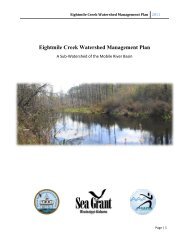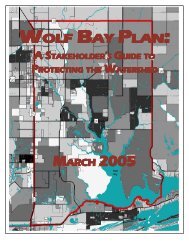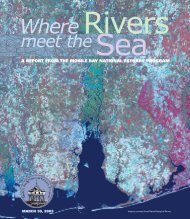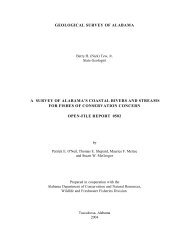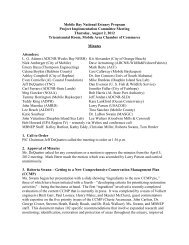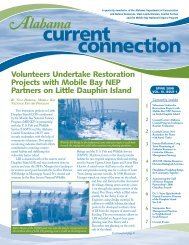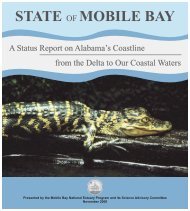Conserving Alabama's Coastal Habitats - Mobile Bay National ...
Conserving Alabama's Coastal Habitats - Mobile Bay National ...
Conserving Alabama's Coastal Habitats - Mobile Bay National ...
- No tags were found...
Create successful ePaper yourself
Turn your PDF publications into a flip-book with our unique Google optimized e-Paper software.
Associated with the Atmore soil series, the buckwheat tree dominates the understory and in some instances reachesdiameters of over six inches and heights of over 25 feet. If fire is excluded, the open, herbaceous character of thepitcher plant flat is lost and titi thickets, consisting of evergreen shrubs, become dominant.Titi thickets are most prevalent on sandy soil in draws and flats along drainage ways and creeks of the lowercoastal plain. They are situated in seepage zones on lower slopes of sandy uplands and along creek channels withhigh water tables. The shrubs aggressively encroach into moist uplands if fire is suppressed. Swamp titi andbuckwheat tree are the most common shrubs. Other common shrubs are fetterbush, large gallberry and bayberry.Shrubby swamp trees, including sweet bay, black gum and slash pine, are often sprinkled throughout the thickets.Ground surfaces are fully shaded and usually exhibit an accumulation of litter. Large amounts of leaf litter oftenbecome trapped in branches and build up on the ground. These conditions limit the presence of herbs.Titi thickets are an association of shrubs, vines and small trees that persist until being felled by logging orconsumed by fire. Stands often become an impenetrable mass of thorny vines (mostly catbrier) woven throughoutthe dense shrubbery. Thickets can be virtually inaccessible by humans until plants become older, taller andmore widely spaced. Shrubs become trees with large trunk dimensions and heights over 25 to 40 feet.(Source: http://www.mdwfp. com/Level2/cwcs/Final/Chapter%204.%20Habitat%20Type%206.pdf)The longleaf pine savanna (a.k.a. “sandhills”, “high pine” and “longleaf pine flatwoods”) is an ecological communitythat depends on naturally occurring fires for its existence. In the past, lightning ignited ground fires swept acrossthe landscape every year or two. The flammable wiregrass, which carried the fire, grew back within days after aburn. Mature longleaf pines have thick bark that insulates from ground fires, and they grew far enough apart thatfire couldn’t spread between their crowns.Young longleafs are vulnerable to fire only during the brief period between the grass stage (when the vulnerablegrowing tip is protected inside a tuft of needles) and the sapling stage, when the growing tip is above the flames.Without frequent fires, other plant species that are not tolerant of fire (e.g., turkey oak, laurel oak, live oak (Q.virginiana), water oak (Q. nigra), red maple (Acer rubrum), and slash pine) invade the pine savanna community andout compete the longleafs and the wiregrass. When the frequency of natural fires was reduced by Europeansettlers who created fireproof barriers like roads, fields, and settlements that stopped the progression of naturalfires, and by outright fire suppression, these and other fire intolerant plants invaded the longleaf pine savanna.Today, remnants of the original fire-maintained ecosystem persists only in conservation areas such as state andnational parks and forests, and Nature Conservancy preserves. (Source:http://www.floridata.com/ref/p/pinu_pal. cfm)Longleaf pine forests were historically widespread in Alabama, occurring above the Fall Line in the Ridge andValley and Piedmont and below the Fall Line in the Southeastern Plains. Longleaf pine habitats range from moistto very well drained sites, including mesic pine flatwoods, pine/scrub oak (Quercus spp.) sandhill, and xericsandhill scrub. “Mountain” longleaf communities occur on rugged ridges north of the Fall Line, including some ofAlabama’s highest elevations. Frequent fire maintains a canopy dominated by longleaf pine, with wiregrass (Aristdabeyrichiana) or other grass/herb ground cover. When fire is infrequent, scrub oaks, other hardwoods, and shrubsbecome common in the midstory and shade out native grasses and forbs. Embedded within longleaf pine habitatsare fire-dependent herbaceous bogs and isolated wetlands that contribute much of the biodiversity of the region.45




